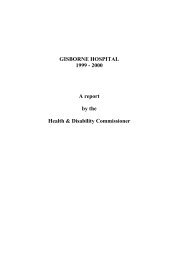09HDC01565 - Health and Disability Commissioner
09HDC01565 - Health and Disability Commissioner
09HDC01565 - Health and Disability Commissioner
Create successful ePaper yourself
Turn your PDF publications into a flip-book with our unique Google optimized e-Paper software.
Opinion <strong>09HDC01565</strong><br />
Viewing patients immediately after report: My original comments regarding Nurse<br />
[Ms K‘s] actions on entering the SCU st<strong>and</strong>. Despite comments from Nurse [Ms K]<br />
<strong>and</strong> Ms A. Pirret, the purpose of the SCU is to care for patients who are seriously<br />
unwell or have the potential to deteriorate rapidly <strong>and</strong> require skilled neuroscience<br />
care <strong>and</strong> observation. This care <strong>and</strong> observation should have included a visual of each<br />
patient after receiving report. I underst<strong>and</strong> from Nurse [Ms K‘s] statement that she<br />
―felt confident in relying on RN [Ms J‘s] report that [Mr A] was stable‖. However<br />
clinical h<strong>and</strong>over is the transfer of responsibility <strong>and</strong>/or accountability for patient care<br />
from one nurse to another nurse. To verify the accuracy of h<strong>and</strong>over information the<br />
nurse should actually look <strong>and</strong> see for themselves. Nurse [Ms K] stated that on<br />
entering [the SCU] ―all three patients were due to be observed at the same time‖. She<br />
saw one patient coming out of the bathroom <strong>and</strong> could see the other patient <strong>and</strong> his<br />
monitor. So why didn‘t she go see [Mr A], who was not clearly visible, to make sure<br />
all was OK (verify)? In reading her statement she states ―it is easy to make a visual<br />
assessment immediately on entering the room‖… but because his curtain was closed<br />
she decided not to look. I do not believe this is reasonable practice in this situation.<br />
Resuscitation practice: Nurse [Ms K] has explained her variation in sequence upon<br />
finding [Mr A]. I underst<strong>and</strong> why she would have reverted to the older adult collapse<br />
sequence under this stressful situation. It appears that the arrest team <strong>and</strong> all activities<br />
were carried out in a timely fashion.<br />
Time of death: I am not qualified to determine time of death however Ms A. Pirret<br />
felt that from Nurse [Ms K‘s] description [Mr A] may have arrested ―more than a few<br />
minutes prior to 0730 hours‖. On the other h<strong>and</strong> Nurse [Ms K] states ―it was clear that<br />
he had been dead for some time‖. Because no one saw [Mr A] from 0615 to 0730<br />
hours <strong>and</strong> there are conflicting reports as to whether he was on oxygen saturation<br />
monitoring, it would be difficult to determine when his deterioration <strong>and</strong> subsequent<br />
arrest occurred.<br />
[The] CDHB customer services manager, is concerned that my original opinion<br />
suggests that some staff, by way of their individual actions (or in-actions), have<br />
contributed to [Mr A‘s] death. As the expert advisor my main concern in this case was<br />
that [Mr A] (or any patient) in the CDHB Special Care Unit was not seen by a nurse<br />
from 0615 to 0730 hours.<br />
I commend the changes Nurses [J, K <strong>and</strong> I] have made relevant to their practice since<br />
this incident.<br />
I am pleased to read that h<strong>and</strong>over now occurs in the SCU at every shift.<br />
Janet Hewson RN MN<br />
Nurse Advisor‖<br />
61 5 September 2012<br />
Names have been removed (except Canterbury DHB <strong>and</strong> the experts who advised on this case) to<br />
protect privacy. Identifying letters are assigned in alphabetical order <strong>and</strong> bear no relationship to the<br />
person’s actual name.
















